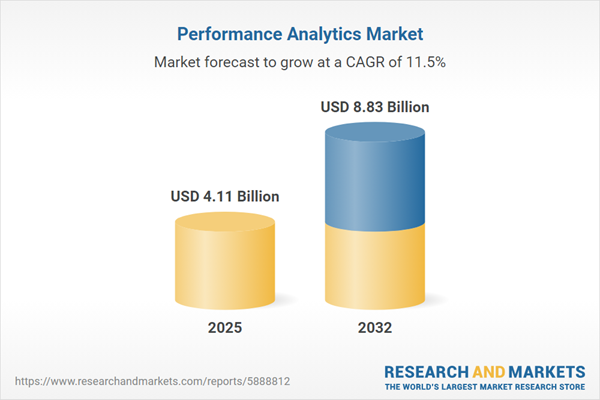Speak directly to the analyst to clarify any post sales queries you may have.
Performance analytics is transforming the way enterprises identify operational risks, allocate resources, and ensure regulatory alignment. Modern organizations increasingly turn operational data into targeted intelligence, enabling leaders to strengthen governance, improve agility, and maintain relevance in complex market environments.
Market Snapshot: Performance Analytics Market Size & Growth
The Performance Analytics Market is entering a period of sustained expansion as organizations sharpen their data-driven strategies. Valued at USD 3.70 billion in 2024, the market is forecast to climb to USD 8.83 billion by 2032, achieving a compound annual growth rate (CAGR) of 11.48%. This momentum stems from the need for predictive and prescriptive analytics across dynamic sectors, allowing businesses to respond nimbly to shifts in regulation, competition, and customer demand. Adoption of advanced analytics tools is enabling enterprises to improve real-time decision-making, drive process optimization, and enhance risk mitigation capabilities, supporting long-term competitiveness.
Scope & Segmentation of the Performance Analytics Market
A clear understanding of the performance analytics market’s scope and segmentation empowers organizations to align procurement, compliance processes, and digital transformation initiatives. Key segments include technologies, end-user sectors, and delivery models, each influencing adoption strategies and investment priorities.
- Product Types: Hardware solutions such as servers and networking equipment support large-scale analytics, while software options offer platforms, dashboards, real-time analysis, and integration middleware. Services span implementation, system integration, and ongoing performance optimization to ensure sustained value.
- End Users: Analytics are central to healthcare, public sector, manufacturing, utilities, and residential industries, where goals range from compliance management and risk reduction to process efficiency and sector-specific reporting.
- Distribution Channels: Solutions are acquired through direct vendor engagement, system integrators, and digital marketplaces, each supporting compliant procurement and centralized governance.
- Deployment Modes: Enterprises select from public cloud, private cloud, hybrid, or on-premises systems based on privacy requirements, industry regulations, and scalability considerations.
- Pricing Models: Flexible models include pay-as-you-go, perpetual license, subscription, and tailored contracts to accommodate business needs and shifting operational demands.
- Technologies: Deployment is enabled by artificial intelligence, machine learning, big data analytics, visual analytics, natural language processing, deep learning algorithms, NoSQL databases, blockchain, and IoT, making actionable insights accessible for varied user groups.
- Regional Coverage: Adoption varies by region, with Americas, Europe, Middle East & Africa, and Asia-Pacific markets shaped by differences in regulatory landscape and digital readiness.
- Featured Companies: Leading providers such as Microsoft, Salesforce, QlikTech International, SAS Institute, SAP SE, Oracle, IBM, TIBCO Software, MicroStrategy, and Domo offer comprehensive platforms and professional services for enterprise-scale analytics needs.
Performance Analytics Market: Key Takeaways
- Modern analytics platforms increase organizational agility by enabling real-time monitoring of key operational and market dynamics, supporting decisive action when conditions change.
- Hybrid and cloud deployment architectures offer flexibility for unique compliance, privacy, and regulatory frameworks across industries, reducing implementation barriers.
- Low-code and no-code solutions are democratizing access to analytics, letting business users generate insights without specialized technical skills.
- Evolving procurement strategies support scalable investments, empowering enterprises to adjust quickly as business processes and risk profiles change.
- Heightened attention to cybersecurity and operational stability is guiding organizations to partner with solution providers that demonstrate sector-specific compliance and governance expertise.
Impact of 2025 United States Tariffs on the Performance Analytics Ecosystem
The introduction of United States tariffs on hardware is driving organizations to reassess sourcing and contract models, resulting in a strategic emphasis on nearshoring and adaptive supply chain management. Enterprises are increasing regulatory monitoring and exploring diversified supplier networks, ensuring business continuity and resilience as procurement and pricing strategies evolve in response to new trade regulations.
Performance Analytics Market Methodology & Data Sources
This analysis is based on in-depth interviews with senior executives, systematic reviews of leading industry publications, government reports, and validated sector datasets. Each finding is corroborated by multiple sources to ensure accuracy and meaningful insight for decision-making.
Why This Report Matters to Senior Decision-Makers
- Delivers a comprehensive structure for assessing vendor options and risk profiles across the fast-evolving landscape of performance analytics.
- Offers guidance on technology selection and compliance strategies bespoke to regulatory and industry shifts.
- Highlights key differentiators among providers and geographical markets, enabling confident, data-driven planning in complex business settings.
Conclusion
Executives can apply these intelligence-driven insights to optimize analytics investments, reinforce governance frameworks, and boost resilience as the performance analytics landscape evolves.
Additional Product Information:
- Purchase of this report includes 1 year online access with quarterly updates.
- This report can be updated on request. Please contact our Customer Experience team using the Ask a Question widget on our website.
Table of Contents
3. Executive Summary
4. Market Overview
7. Cumulative Impact of Artificial Intelligence 2025
Companies Mentioned
The companies profiled in this Performance Analytics market report include:- Microsoft Corporation
- Salesforce, Inc.
- QlikTech International AB
- SAS Institute Inc.
- SAP SE
- Oracle Corporation
- International Business Machines Corporation
- TIBCO Software Inc.
- MicroStrategy Incorporated
- Domo, Inc.
Table Information
| Report Attribute | Details |
|---|---|
| No. of Pages | 188 |
| Published | October 2025 |
| Forecast Period | 2025 - 2032 |
| Estimated Market Value ( USD | $ 4.11 Billion |
| Forecasted Market Value ( USD | $ 8.83 Billion |
| Compound Annual Growth Rate | 11.4% |
| Regions Covered | Global |
| No. of Companies Mentioned | 11 |









